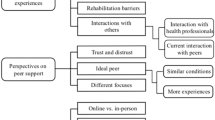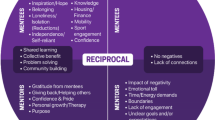Abstract
Study design:
Systematic review and meta-synthesis of qualitative findings.
Objectives:
To establish the perceived effectiveness and mechanisms of community peer-based programmes based on narratives of consumers with spinal cord injury (SCI).
Methods:
Scopus, Academic Search Complete, CINAHL, Health Source, Medline, PsycARTICLES, PsychINFO, SPORTSDiscus and ProQuest were searched for articles published in English between January 1990 and December 2015. Qualitative studies referring to community peer-based interventions were included if most cases had a SCI. The results section of included studies was extracted and entered in NVivo. Data were inductively coded and analysed according to the three phases of Thematic Synthesis.
Results:
The search yielded 1402 unique records, out of which 126 were scrutinised in full. Four studies were appraised based on eight criteria and were finally included in the analysis. Three analytical themes emerged: (1) a unique learning environment created by the right mixture of learning resources, learning processes and a can-do attitude; (2) peer mentors—a unique learning resource with high level of relatedness that eases and empowers participants; and (3) an intervention that responds to important unmet needs and unrealised potential.
Conclusions:
Community peer-based programmes for people with SCI provide individualised training in important life areas, using a variety of learning resources and a plethora of learning processes. The high level of perceived effectiveness suggests that this type of intervention is an important tool of health systems post discharge from initial rehabilitation. Community organisations should be supported with evaluating their programmes through quality research.
This is a preview of subscription content, access via your institution
Access options
Subscribe to this journal
Receive 12 print issues and online access
$259.00 per year
only $21.58 per issue
Buy this article
- Purchase on SpringerLink
- Instant access to full article PDF
Prices may be subject to local taxes which are calculated during checkout

Similar content being viewed by others
References
World Health Organization. International Perspectives on Spinal Cord Injury WHO: Geneva, Switzerland. 2013.
Smith M . Efficacy of specialist versus non-specialist management of spinal cord injury within the UK. Spinal Cord 2002; 40: 11–16.
Tator CH, Duncan EG, Edmonds VE, Lapczak LI, Andrews DF . Neurological recovery, mortality and length of stay after acute spinal cord injury associated with changes in management. Paraplegia 1995; 33: 254.
Parent S, Barchi S, Lebreton M, Casha S, Fehlings MG . The impact of specialized centers of care for spinal cord injury on length of stay, complications, and mortality: a systematic review of the literature. J Neurotrauma 2011; 28: 1363.
Divanoglou A, Westgren N, Bjelak S, Levi R . Medical conditions and outcomes at 1 year after acute traumatic spinal cord injury in a Greek and a Swedish region: a prospective, population-based study. Spinal Cord 2010; 48: 470–476.
Divanoglou A, Westgren N, Seiger Å, Hulting C, Levi R . Late mortality during the first year after acute traumatic spinal cord Injury: a prospective, population-based study. J Spinal Cord Med 2010; 33: 117.
Devivo MJ . Sir Ludwig Guttmann Lecture: trends in spinal cord injury rehabilitation outcomes from model systems in the United States: 1973–2006. Spinal Cord 2007; 45: 713.
Bloemen-Vrencken JHA, Witte LPD, Post MWM . Follow-up care for persons with spinal cord injury living in the community: a systematic review of interventions and their evaluation. Spinal Cord 2005; 43: 462.
Suddick K, O’Neill A . Reintegration and rehabilitation after spinal cord injury: a small-scale pilot study. Int J Ther Rehab 2009; 16: 535–544.
Cott C . Client-centred rehabilitation: client perspectives. Disabil Rehabil 2004; 26: 1411–1422.
Dickson A, Ward R, O’Brien G, Allan D, O’Carroll R . Difficulties adjusting to post-discharge life following a spinal cord injury: an interpretative phenomenological analysis. Psychol Health Med 2011; 16: 463–474.
Nunnerley JL, Hay-Smith EJC, Dean SG . Leaving a spinal unit and returning to the wider community: an interpretative phenomenological analysis. Disability and Rehabilitation. Disabil Rehabil 2013; 35: 1164–1173.
Craig A, Nicholson Perry K, Guest R, Tran Y, Dezarnaulds A, Hales A et al. Prospective study of the occurrence of psychological disorders and comorbidities after spinal cord injury. Arch Phys Med Rehabil 2015; 96: 1426–1434.
Kennedy P, Sherlock O, Mcclelland M, Short D, Royle J, Wilson C . A multi-centre study of the community needs of people with spinal cord injuries: the first 18 months. Spinal Cord 2009; 48: 15.
Dattilo J, Caldwell L, Lee Y, Kleiber DA . Returning to the community with a spinal cord injury: Implications for therapeutic recreation specialists. Ther Recreation J 1998; 32: 13–27.
Craig A, Nicholson Perry K, Guest R, Tran Y, Middleton J . Adjustment following chronic spinal cord injury: determining factors that contribute to social participation. Br J Health Psychol 2015; 20: 807–823.
Sweet SN, Noreau L, Leblond J, Martin Ginis KA . Peer support need fulfillment among adults with spinal cord injury: relationships with participation, life satisfaction and individual characteristics. Disabil Rehabil 2016; 38: 558.
Letts L, Ginis KAM, Colquhoun H, Levac D, Faulkner G, Gorczynski P . Preferred methods and messengers for delivering physical activity information to people with spinal cord injury: a focus group study. Rehabil Psychol 2011; 56: 128–137 10p.
McAweeney MJ, Forchheimer M, Tate DG . Identifying the unmet independent living needs of persons with spinal cord injury. J Rehabil 1996; 62: 29–34 6p.
Heisler M . Building peer support programs to manage chronic disease: seven models for success. California HealthCare Foundation 2006.
Erwin EJ, Brotherson MJ, Summers JA . Understanding qualitative metasynthesis: issues and opportunities in early childhood intervention research. J Early Interv 2011; 33: 186–200.
Harris J . Using qualitative research to develop robust effectiveness questions and protocols for Cochrane systematic reviews. 2011. In: Supplementary Guidance for Inclusion of Qualitative Research in Cochrane Systematic Reviews of Interventions [Internet]. Cochrane Collaboration Qualitative Methods Group. Available from: http://cqrmg.cochrane.org/supplemental-handbook-guidance.
Tong A, Flemming K, McInnes E, Oliver S, Craig J . Enhancing transparency in reporting the synthesis of qualitative research: ENTREQ. BMC Med Res Methodol 2012; 12: 181.
Thomas J, Harden A . Methods for the thematic synthesis of qualitative research in systematic reviews. BMC Med Res Methodol 2008; 8: 45.
Barnett-Page E, Thomas J . Methods for the synthesis of qualitative research: a critical review. BMC Med Res Methodol 2009; 9: 59.
Sandelowski M, Barroso J . Handbook for Synthesizing Qualitative Research. New York, USA: Springer Publishing Company. 2007.
Creswell JW, Miller DL . Determining validity in qualitative inquiry. Theory into Practice 2000; 39: 124–130.
Bates MJ . The design of browsing and berrypicking techniques for the online search interface. Online Rev 1989; 13: 407–424.
Rees R, Oliver K, Woodman J, Thomas J . Children’s Views About Obesity, Body Size, Shape and Weight: a Systematic Review. London: EPPI-Centre, Social Science Research Unit, Institute of Education, University of London: University of London, London, UK: EPPI-Centre SSRU, Institute of Education, 2009.
Donabedian A . An Introduction to Quality Assurance in Health Care. New York, USA: Oxford University Press. 2003.
Walsh D, Downe S . Meta‐synthesis method for qualitative research: a literature review. J Adv Nurs 2005; 50: 204–211.
Ashton-Shaeffer C, Gibson HJ, Autry CE, Hanson CS . Meaning of sport to adults with physical pisabilities: a disability sport camp experiecnce. Sociol Sport J 2001; 18: 95–114.
Block P, Vanner EA, Keys CB, Rimmer JH, Skeels SE . Project shake-It-up: using health promotion, capacity building and a disability studies framework to increase self efficacy. Disabil Rehabil 2010; 32: 741–754.
Conway T . Exploration of the Experiences and Perceptions of Spinal Cord Injured People who attend Outdoor Recreation Programmes. http://hdl.handle.net/10523/626. University of Otago: Dunedin, New Zealand. 2010.
Standal OF, Jespersen E . Peers as resources for learning: a situated learning approach to adapted physical activity in rehabilitation. Adapt Phys Act Q 2008; 25: 208–227.
Hammell KW . Experience of rehabilitation following spinal cord injury: a meta-synthesis of qualitative findings. Spinal Cord 2007; 45: 260–274.
Caldwell LL, Dattilo J, Kleiber DA, Lee Y . Perceptions of therapeutic recreation among people with spinal cord injury. Annu Ther Recreation 1994; 5: 13–26 14p.
Goodwin D, Peco J, Ginther N . Hiking excursions for persons with disabilities: experiences of interdependence. Ther Recreation J 2009; 43: 43–55.
Litchke LG, Hodges JS, Schmidt EA, Lloyd LK, Payne E, Russian CJ . Personal meaning of wheelchair rugby participation by five male athletes. Ther Recreation J 2012; 46: 26–41.
Jalovcic D, Pentland W . Telephone peer support program for women with spinal cord injuries. Proceedings of the 9th Congress of European Federation for Research in Rehabilitation, Budapest, Hungary, 26-29 August 2007. Int J Rehabil Res 2007; 30: 73–74 2p.
Perlman D . Project Quila: a case study in community-based rehabilitation. ProQuest Dissertations Publishing 1997, p392.
Craig A, Rodrigues D, Tran Y, Guest R, Bartrop R, Middleton J . Developing an algorithm capable of discriminating depressed mood in people with spinal cord injury. Spinal Cord 2014; 52: 413.
Guest R, Craig A, Tran Y, Middleton J . Factors predicting resilience in people with spinal cord injury during transition from inpatient rehabilitation to the community. Spinal Cord 2015; 53: 682–686.
Bandura A . Self-efficacy: toward a unifying theory of behavioral change. Psychol Rev 1977; 84: 191–215.
Ryan RM, Deci EL . Self-determination theory and the for intrinsic motivation, social development, and well-being. Am Psychol 2000; 55: 68–78.
Ryan RM, Deci EL . Intrinsic and extrinsic motivations: classic definitions and new directions. Contem Edu Psychol 2000; 25: 54–67.
Deci E, Ryan R . Intrinsic Motivation and Self-Determination in Human Behavior. New York: Springer USA. 1985.
Bandura A . Social cognitive theory: an agentic perspective. Asian J Soc Psychol 1999; 2: 21–41.
Ginis K, Nigg C, Smith A . Peer-delivered physical activity interventions: an overlooked opportunity for physical activity promotion. Transl Behav Med 2013; 3: 434–443.
Rimmer JH, Riley B, Wang E, Rauworth A, Jurkowski J . Physical activity participation among persons with disabilities: barriers and facilitators. Am J Prev Med 2004; 26: 419–425.
Dryden DM, Saunders LD, Rowe BH, May LA, Yiannakoulias N, Svenson LW et al. Utilization of health services following spinal cord injury: a 6-year follow-up study. Spinal Cord 2004; 42: 513.
Institute of Medicine (IOM). Evidence-based Medicine and the Changing Nature of Health Care: 2007 IOM Annual Meeting Summary. The National Academies Press: Washington, DC, USA. 2008.
Ginis KAM, Latimer-Cheung A, Corkum S, Ginis S, Anathasopoulos P, Arbour-Nicitopoulos K et al. A case study of a community-university multidisciplinary partnership approach to increasing physical activity participation among people with spinal cord injury. Transl Behav Med 2012; 2: 516–522.
Acknowledgements
We would like to acknowledge Dr Michele Wolfe, Kenneth Chance-Larsen and Dr Luke Heales for providing editing support at the final stages of the manuscript. We would also like to acknowledge Dr Wendy Madsen for providing advice in the initial steps of this review.
Author information
Authors and Affiliations
Corresponding author
Ethics declarations
Competing interests
The authors declare no conflict of interest.
Additional information
Supplementary Information accompanies this paper on the Spinal Cord website
Rights and permissions
About this article
Cite this article
Divanoglou, A., Georgiou, M. Perceived effectiveness and mechanisms of community peer-based programmes for Spinal Cord Injuries—a systematic review of qualitative findings. Spinal Cord 55, 225–234 (2017). https://doi.org/10.1038/sc.2016.147
Received:
Revised:
Accepted:
Published:
Issue Date:
DOI: https://doi.org/10.1038/sc.2016.147
This article is cited by
-
Knowledge translation gaps that need to be bridged to enhance life for people with spinal cord injury
Spinal Cord Series and Cases (2024)
-
The vulnerable superhero—a qualitative study investigating how spinal cord injury peer mentors experience their role in Active Rehabilitation training programs
Spinal Cord (2023)
-
Sexuality Support After Spinal Cord Injury: What is Provided in Australian Practice Settings?
Sexuality and Disability (2022)
-
Outcomes of peer mentorship for people living with spinal cord injury: perspectives from members of Canadian community-based SCI organizations
Spinal Cord (2021)
-
Causes of death after spinal cord injury in the Czech Republic
Spinal Cord (2021)



